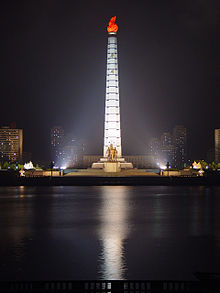- Juche Tower
-
Juche Tower 
Korean name Chosŏn'gŭl 주체사상탑 Hancha 主體思想塔 McCune–Reischauer Chuch'e Sasangt'ap Revised Romanization Juche Sasangtap The Juche Tower (officially the Tower of the Juche Idea) is a monument in Pyongyang, North Korea. The tower is named after the principle of Juche, developed by Kim Il Sung as a blend of autarky, self-reliance, nationalism, isolationism, Korean traditionalism, and Marxism-Leninism.
Completed in 1982, it is sited on the eastern bank of the River Taedong, directly opposite Kim Il Sung Square which is situated on the other side of the river. It was made to commemorate Kim Il Sung's 70th birthday. Kim Jong-il is officially credited as the tower's designer;[1] however, interviews with former North Korean officials contradict this assertion.[2]
The 170-metre (560 ft) structure is a four sided tapering 150-metre (490 ft) spire (the tallest in granite) containing 25,550 blocks (365 × 70, one for each day of Kim Il Sung's life, excluding supplementary days), dressed in white stone with seventy dividers and capped with a 20-metre (66 ft) high, 45 ton, illuminated metal torch. It is possible to ascend the tower (there is a lift) and there are wide views over Pyongyang from the viewing platform just below the torch. In the base of the tower there are reception rooms where videos explaining the tower's ideological importance are sometimes shown. It is presumed to be modeled on the Washington Monument, which it surpasses in height by less than a meter.[3] The Juche tower is the second tallest monumental column in the world after the San Jacinto Monument, which is 2.9 metres (9.5 ft) taller.
Associated with the tower is a 30-metre (98 ft) high statue consisting of three figures—one with a hammer, one with a sickle and one with a writing brush (an idealised worker, a peasant and a "working intellectual", inspired by the Russian Worker and Kolkhoz Woman statue. The combination of symbols recalls the flag of the Workers' Party of Korea). There are six smaller groups, each 10 metres (33 ft) high, symbolizing other aspects of Kim Il Sung's ideology. Also close to the tower is a wall of 82 friendship plaques, apparently from foreign supporters. Around the tower there are also pavilions and water features. It is claimed that the tower has become a popular site for North Koreans.[4]
Pyongyang, the capital, often experiences power shortages; however, the Juche Tower is always brightly lit to preserve symbolic strength.
A number of North Korean support groups—and the Gabonese president and North Korea ally Omar Bongo—have supported the construction of the tower and are awarded plaques on the base of the tower.
Gallery
Notes
- ^ Coonan, Clifford (October 21, 2006). "Kim Jong Il, the tyrant with a passion for wine, women and the bomb". The Independent. http://www.independent.co.uk/news/world/asia/kim-jong-il-the-tyrant-with-a-passion-for-wine-women-and-the-bomb-421016.html. Retrieved October 11, 2008.
- ^ Martin, Bradly K. (2004). Under The Loving Care of The Fatherly Leader. Macmillan. pp. 626. ISBN 0312322216.
- ^ McCormack, Gavan, Target North Korea: Pushing North Korea to the Brink of Nuclear Catastrophe, p. 59. Nation Books, 2004, ISBN 1560255579.
- ^ "Tower of Juche Idea Draws Endless Stream of Visitors". KCNA. April 13, 2009. http://www.kcna.co.jp/item/2009/200904/news13/20090413-09ee.html. Retrieved August 15, 2009.
External links
- Asian Historical Architecture: Juche Tower
- Google Maps satellite photo
- The Juche Idea, Shine All Over The World! (Epitaph enshrined in the Tower of Juche Idea)
Coordinates: 39°1′3.52″N 125°45′48.05″E / 39.0176444°N 125.7633472°E
Categories:- Buildings and structures completed in 1982
- Buildings and structures in Pyongyang
- Monuments and memorials in North Korea
- Towers in North Korea
- National symbols of North Korea
- Visitor attractions in Pyongyang
Wikimedia Foundation. 2010.



